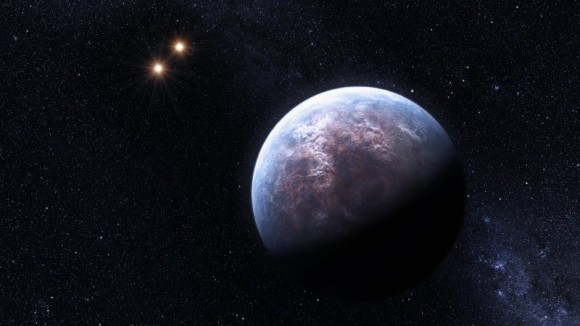A planet 6 times the mass of Earth orbits around the star Gliese 667 C, another member of a triple star system. Credit: ESO
 Until recently, astronomers were highly skeptical of whether or not planets should be possible in multiple star systems. It was expected that the constantly varying gravitational force would eventually tug the planet out of orbit. But despite doubts, astronomers have found several planets in just such star systems. Recently, astronomers announced another, this time in the trinary star HD 132563.
Until recently, astronomers were highly skeptical of whether or not planets should be possible in multiple star systems. It was expected that the constantly varying gravitational force would eventually tug the planet out of orbit. But despite doubts, astronomers have found several planets in just such star systems. Recently, astronomers announced another, this time in the trinary star HD 132563.
The Astronomical Research Center (A.R.C) mentioned that the detection of the new planet came as part of a larger study on the trinary star system spanning 10 years. The two main stars that comprise the system are both similar to the Sun in mass, although somewhat less prevalent in metals, and orbit each other at a distance of around 400 AU. The main star, HD 132563A is also itself, a binary. This fact was not previously recognized and also reported by the team, led by Silvano Desidera from the Astronomical Observatory in Padova, Italy.
The newly discovered planet orbits the secondary star in the system, HD 132563B. As with the binary component of the main star, the new planet was discovered spectroscopically. The planet is at least 1.3 times the mass of Jupiter, with an average distance from its parent star of 2.6 AU, and an moderately high eccentricity of 0.22.
The team also attempted to image the planet directly using adaptive optics from the Italian Telescopio Nazionale Galileo. While there was a hint in the glare of the star that may have been the planet in question, the team could not rule out that the detection was not an instrumental effect.
With the discovery of this new planet, the total number of discovered planets in multiple star systems lies at eight. while this is rather small numbers from which to draw firm conclusions, it appears that planets can be commonly found orbiting the more remote members of trinary star systems for good periods of time. On the shorter end, the stellar system is anticipated to be 1-3 billion years in aged, based on the amount of stellar activity and amount of lithium present in the star’s atmosphere (which decreases with time). However, fitting of the mass and luminosity onto isochrones suggest the stars may be as much as 5 billion years in age. In either situation, the planetary system is dynamically stable.
Also based on these eight systems, the team also suggests that planets existing around such far removed members of a multiple star system may be as common as planets around wide binaries, or even single stars.